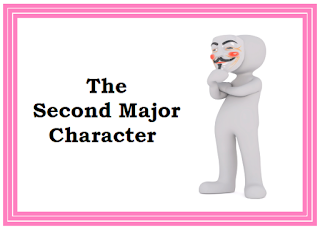Wednesday, April 1, 2020
2020 — April — The Second Major Character
Part 4 of 12 of Job Titles for Story Characters © 2020 All Rights Reserved
Here's a new word for you to ponder—
Deuteragonist
What does deuteragonist mean? It's the second most important character in a drama. Which means, we're talking about the story job title for the Second Major Character.
So, who do you think is the second most important character in a story?
Here's the answer— in order of importance and popularity, the Second Major Character can be the—
Romantic Interest or the Romantic Lead
Best Friend, Sidekick, Pal, etc.
Mentor, Advisor, Teacher, Sage, etc.
The Fool
Can there be more than one Second major Character in a story? Well, yes, there can be. However, do keep in mind that a story can support only so many characters in order to provide a good read and a worthy plot. So, limits must be set.
And, of course, there are Point of View (POV) and Viewpoint considerations. That's why only one Second Major Character could be in the longest of short stories and the shortest of novels. It's in the lengthy novels (over 80,000 words) that there may be a Second Major Character (often the Romantic Lead) with a POV-Viewpoint or even an additional Second Major Character or two, but who don't have POV-Viewpoint.
Here's something to note— Pantsers have a tendency to create additional characters when drafting their story because there's a need to reveal information or a plot point. Instead, the Pantser should look for a way to reveal that information or revelation by using the story's dominant (most important) Second Major Character, or The Fool, or The Mentor, etc.
Now, let's look at each classification of Second Major Character—
ROMANTIC INTEREST OR THE ROMANTIC LEAD
Of all the characters in a story, the Romantic Lead is probably the most popular. The Romantic Lead or Romantic Interest is also the most valuable. That's because just about every genre publisher wants a Romantic Lead plot or subplot— or at least a Romantic Interest subplot. Why? Because that enhances the saleability of a story. After all, most readers and book buyers are women. Even once staunchly male genres are being influenced by women readers. But writing a romance subplot or even including a Romantic Lead requires knowing The Romance Journey (similar to the Hero's Journey) and how to incorporate it into a story.
BEST FRIEND, SIDEKICK, PAL
Just because the main character has a best friend (even of the BFF—best friend forever—category) doesn’t mean there’s not going to be some conflict between them. In almost every protagonist-BFF relationship, there ends up being some sort of falling out part-way through the story that causes additional conflict for the main characters. Look at Harry, Ron and Hermione in the Harry Potter series. It seems like two of the three friends are invariably fighting or arguing about what Harry should or shouldn't do. The only thing that seems to change is which two happen to be getting along at any given moment in the story.
Believability is also strengthened by the interplay of the Protagonist with their BFF, sidekick, and pals. Even the Antagonist can influence, terrify, or threaten such friends.
THE FOOL
In Shakespearean terms, The Fool is a character (usually the court jester) who says the things that the protagonist may not want to hear but needs to hear.
In The Hero's Journey, often The Trickster archetype provides comic relief— and often points out the Protagonist's all too human follies, hypocrisy, or insincerity.
Just because The Fool is called “The Fool” doesn’t mean he or she is foolish or stupid. Often The Fool turns out to be the wisest character in the story, sharing pearls of wisdom with the rest of the characters, only no one seems to listen to The Fool. Examples: Haymitch from The Hunger Games trilogy.
One last reminder—
In these days of the coronavirus and being housebound to keep yourself and others safe, here's a CDC link I found helpful—
https://www.cdc.gov/coronavirus/2019-ncov/prepare/index.html
Stay safe.
Stay healthy.
We're all in this together.
— Catherine E. McLean
**************
Next Month - May The Antagonist - The Who
# # #
Subscribe to:
Post Comments (Atom)

1 comment:
Thanks for the tips, Catherine. "Deuteragonist" was new to me. I checked Merriam-Webster to see if I pronounced it correctly. I didn't. I had mispronounced the accented syllable "rag." Maybe my old eyes saw an "0" instead of an "a." More likely I concentrated on the beginning and end.
Post a Comment